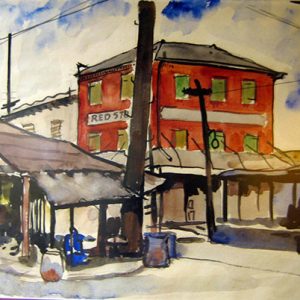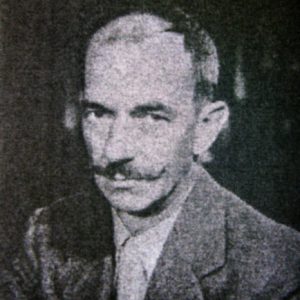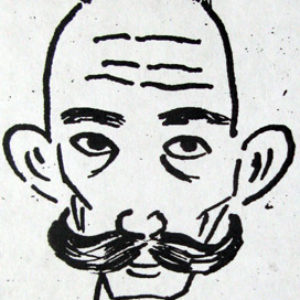calsfoundation@cals.org
James Powell Scott (1909–1982)
James Powell Scott was a prominent mid-twentieth-century American artist and art educator. He began studying, producing, and teaching art in Arkansas. Now best remembered for his lithographs, watercolors, and oil paintings on canvas, Scott has works in the collections of major regional and national art museums, including the National Gallery of Art in Washington DC.
James Powell Scott, the second of three sons, was born to Wellington Friend Scott and Sarah Powell Scott on April 22, 1909, in Lexington, Kentucky. He attended public schools in Kentucky and in Arkansas after his family moved to Little Rock (Pulaski County). In 1928, Scott graduated from Little Rock High School.
Scott studied art fundamentals with Adrian Brewer, a popular Little Rock artist and teacher. Brewer and other art critics soon recognized Scott as one of Arkansas’s most promising young artists. With Brewer’s encouragement to obtain the best art training possible, Scott entered the Art Institute of Chicago school in 1929. As a student of Louis Ritman, Francis Chapin, and Boris Anisfeld, Scott excelled in studio art courses.
In 1931, Scott’s lithograph Bacchant was accepted for the second International Exhibition of Lithography and Wood Engraving in Chicago, Illinois. That same year, a collection of his lithographs was exhibited in Lexington, Kentucky. In 1932, his lithograph Market was chosen for the third International Exhibition of Lithography. During his time at the Art Institute of Chicago, Scott gained valuable teaching experience serving as an assistant in lithography.
Scott became absorbed in watercolor as a medium and produced many interesting pieces. One untitled watercolor was displayed at the International Water Color Show in Chicago in 1931.
Following graduation in 1932, Scott returned to Depression-era Little Rock. Scott kept busy designing and printing book plates, painting watercolors and sketches around the city, and producing children’s portraits. Soon, he found work teaching art under the New Deal’s Public Works of Art Project, a government program created to provide economic relief for artists. In 1934, Scott served as assistant director for his former teacher at the Adrian Brewer School of Art.
Scott moved to Tucson, Arizona, in 1935, where he was employed as an instructor in art at the University of Arizona. From 1942 through 1946, his university teaching was interrupted by World War II. Scott entered the U.S. Army Air Forces as a private, was commissioned the next year, and rose to the rank of major. Scott served as staff artist for Lieutenant General William H. Tunner, making paintings and drawings pertaining to the Air Transport Command in the China-Burma-India Theater.
Scott painted a series of fifteen watercolors depicting jungle search-and-rescue missions in which he participated. One pictured an airdrop to crash survivors that included items for barter with wilderness natives. Another watercolor showed survivors cooking a monkey over an open fire at night. Scott recalled that everyone “complained that the monkey, although fairly tasty, never failed to bring revulsion when the hands and feet were left on the body.”
In 1946, Scott returned from military leave. That year, one of his paintings was presented in New York City at the National Academy of Design.
Scott’s entire jungle rescue watercolor series was later placed in the permanent historical collection of the U.S. War Department. In 1995, the Department of Defense’s Fiftieth Anniversary of World War II Commemoration Committee honored Scott and other combat artists by exhibiting their wartime paintings and recognizing their service in the Congressional Record.
Scott excelled in figure painting, and many of his works were displayed at exhibitions and galleries in Chicago; St. Louis, Missouri; Little Rock; Phoenix, Arizona; and Tucson. One of Scott’s most interesting paintings, And Now Tomorrow, was a stark piece of realism. Painted in 1949, this oil on canvas recalls portrayals of American alienation. Entirely gray and brown, it pictured four men at the edge of a precipice, looking out into a vast barren space.
Adept in a variety of media, including oil painting, watercolor, charcoal, pen and ink, lithography, bronze casting, and metal sculpture, Scott continued his artistic activity while also teaching painting and figure drawing at the University of Arizona. He retired in 1976 but continued teaching as professor emeritus for two more semesters in his specialty, anatomy for artists.
Scott’s biography has been listed in Who’s Who in American Art, Index of Artists: International-Biographical, The Artists’ Bluebook, Davenport’s Art Reference, Who’s Who for Arizona, and Who Was Who in American Art, 1564–1975. His awards include the Coolbaugh Scholarship to the Art Institute of Chicago, Chicago’s Municipal Art League Prize for Watercolor, Art Students League Exhibition in Chicago, and numerous first prizes from the Tucson Fine Arts Association. Scott’s 1931 lithograph Untitled (Rooms for Rent) is in the permanent collection of the National Gallery of Art. His works are also found in many private and public collections, including the U.S. Department of Defense, the University of Arizona Museum of Art, the Arizona State University Art Museum, and the Tucson Museum of Art.
Scott, a lifelong bachelor, died on June 20, 1982, in Tucson. He was returned to Little Rock and buried with his family at Roselawn Cemetery.
For additional information:
Federal Writers’ Project. WPA Guide to 1930s Arkansas. Lawrence: University Press of Kansas, 1987.
“James Powell Scott (1909–1982).”AskART: The Artists’ Bluebook. http://www.askart.com/AskART/S/james_powell_scott/james_powell_scott.aspx?searchtype=SUMMARY&artist=5263 (accessed January 19, 2022).
McKinney, R. L. “A Little Rock Artist.”Arkansas Gazette Magazine, August 28, 1932, p. 13.
Thomas A. Teeter
Little Rock, Arkansas
 Early Twentieth Century, 1901 through 1940
Early Twentieth Century, 1901 through 1940 Beach Scene
Beach Scene  Cityscape
Cityscape  James Scott
James Scott  Scotty
Scotty 




Comments
No comments on this entry yet.